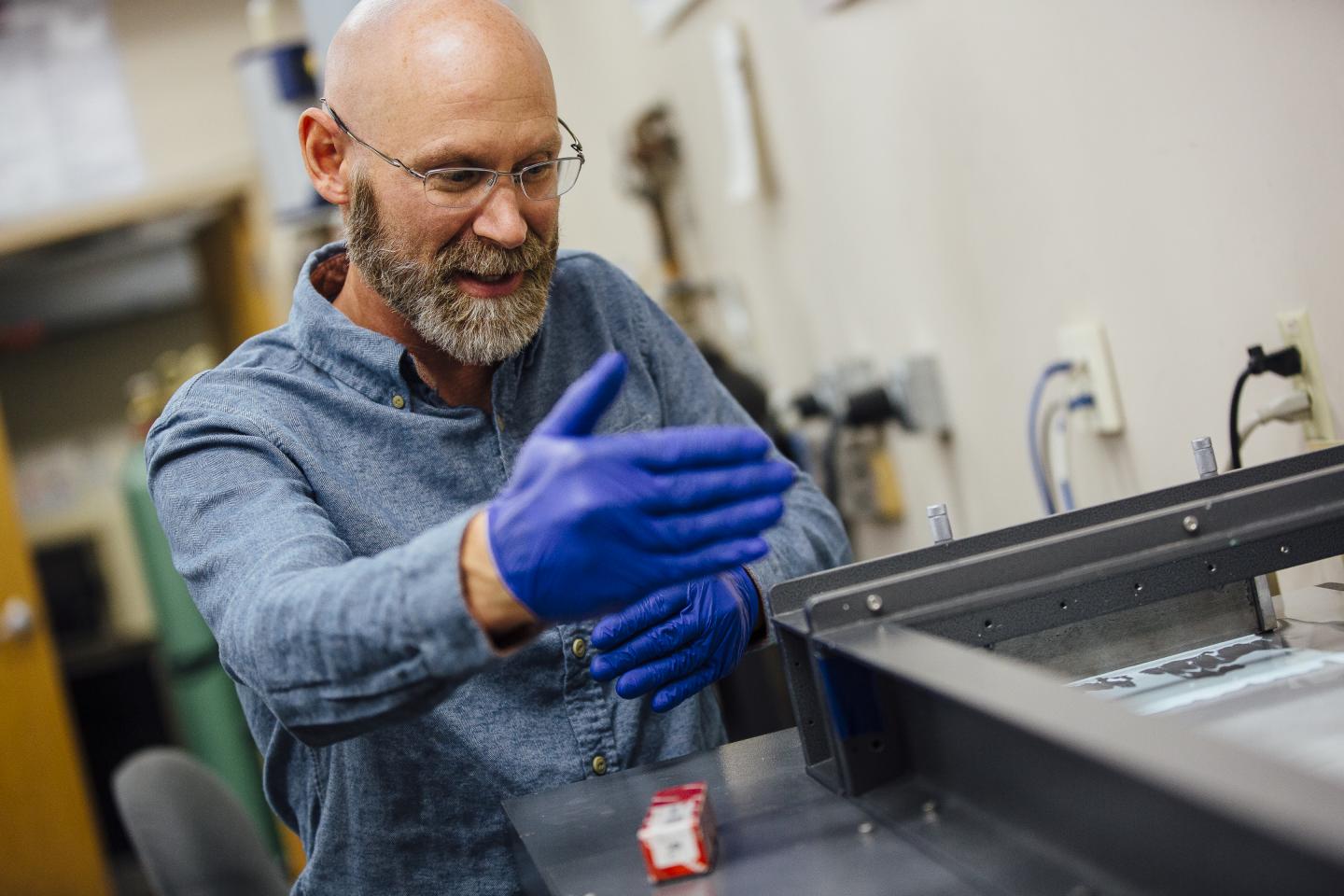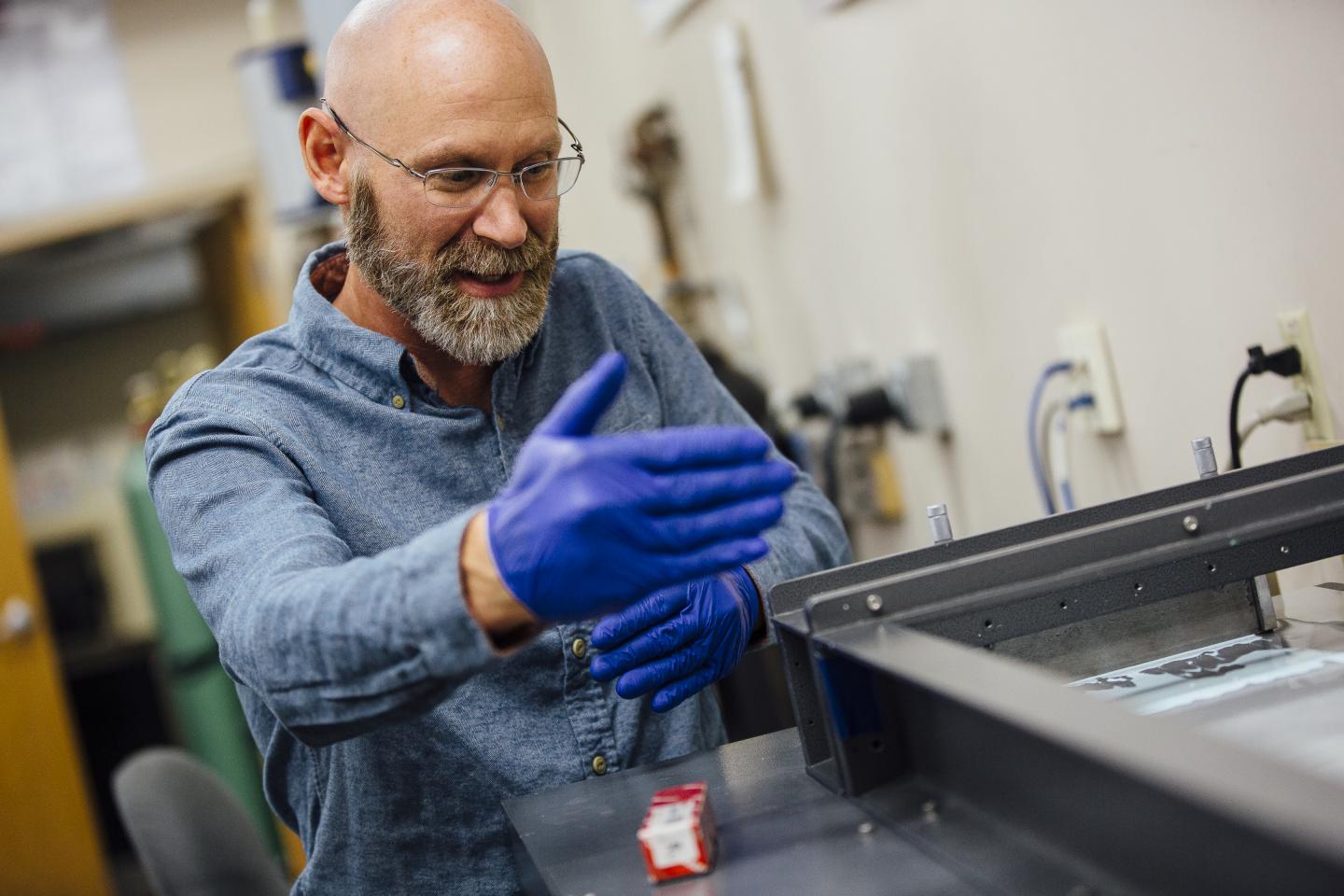
Credit: MSU Photo by Adrian Sanchez-Gonzalez
BOZEMAN — A special ceramic slurry and a conveyor belt whose surface is minus 30 degrees are some of the things a Montana State University researcher will use to help turn carbon dioxide into useful products.
"It's materials science, but there's also an art to it," said Stephen Sofie, professor in the Department of Mechanical and Industrial Engineering.
In his lab recently, Sofie carefully poured the ceramic slurry onto the conveyor surface, where it spread into a thin sheet. As the conveyor moved very slowly over a powerful cold source, small ice crystals formed as the slurry hardened — a process called freeze-casting.
"It's casting really nicely," Sofie said. "It looks simple but there are a lot of details," including the precise mixing of several ingredients in the slurry and the rate at which it freezes, he said.
Once the slurry solidified, Sofie placed it in a freeze-dryer that would remove all the water, leaving tiny pores where the ice crystals once were. The result, a membrane that can control chemical reactions by evenly distributing gases, is a technology that Sofie plans to refine in the coming months with a $1.5 million grant he received from the U.S. Department of Energy in September.
According to Lee Spangler, director of MSU's Energy Research Institute and a co-principal investigator on the project, the freeze-casting method could provide the key to scaling up another technology that converts carbon dioxide to formic acid, a product commonly used as a food additive and in a variety of industrial processes.
The formic acid technology, called ECForm, works by applying electricity as carbon dioxide filters through a membrane. The company that developed the technology, OCO, has demonstrated the process with prototypes, according to OCO co-founder and president Terry Brix, a 1967 MSU chemical engineering alumnus. But scaling it up to the levels needed for industrial production requires membranes whose pore structure can be carefully controlled, he said. That's where Sofie's freeze-casting comes in.
Brix and his son, Todd Brix, CEO of the company, approached Spangler last spring because of MSU Energy Research Institute's work on carbon dioxide sequestration. "We recognized an opportunity," Spangler said. "We realized (OCO) was working on a technology that MSU could help improve." Shortly thereafter, Sofie and Spangler, with OCO's support, put together the Energy Department grant proposal.
"We think this potential improvement could significantly reduce the cost (of ECForm)," Terry Brix said. "That would be a big deal in the chemical engineering world. We're delighted to partner with MSU on this project."
Chemists have long known how to convert carbon dioxide to formic acid, Terry Brix said, but the processes that have been developed to date aren't economically attractive to industry. That why most formic acid produced today is made from petroleum, he said.
Sofie's experience with freeze-casting dates back more than a decade, to graduate research in which he helped pioneer the technique, which is sometimes called ice templating. At NASA's Glenn Research Center, he used freeze-casting to develop membranes for fuel cells that could power spacecraft and modules for human habitation on the moon and Mars.
With the Energy Department funding, Sofie's team will explore ways to advance the technology by precisely controlling the spacing and structure of the pores. Sofie and Spangler hold a provisional patent on a process that involves varying the amounts of ceramic materials in the slurry as it is applied to the conveyor surface, Sofie said.
That could produce custom-made membranes up to 2 feet wide through which large volumes of carbon dioxide would flow in an optimal way for the ECForm process, Terry Brix said. That would reduce the electricity needs — and therefore the cost — of the formic acid reaction, he added.
According to Spangler, if ECForm can be scaled up economically, it would provide an incentive for producers of carbon dioxide — such as coal-fired power plants — to capture the gas and convert it to formic acid, which they could sell for a much higher price than raw carbon dioxide. The new freeze-casting technology could also lead to improved fuel cells, batteries and other products, he said.
The Energy Department-funded project includes a collaboration between MSU and the University of South Florida to develop a new application for formic acid. Ramon Gonzalez, professor in USF's Department of Chemical and Biomolecular Engineering, and his team will investigate ways of using microbes to convert the substance to ethylene glycol, a liquid used in heating and cooling systems and automotive antifreeze.
Sofie is excited that freeze-casting the membranes is environmental friendly as well. "What's really outstanding with our methods is that they are water-based," he said. "There aren't any toxic solvents involved."
Sofie said the research team hopes to demonstrate that it can make the industrial membranes within a year and a half.
"I've been working on (freeze-casting) for such a long time," Sofie said. "Now it's coming to such nice fruition with a big project like this."
###
Media Contact
Stephen Sofie
[email protected]
@montanastate?lang=en
http://www.montana.edu
Original Source
http://www.montana.edu/news/18110/msu-researchers-win-1-5-million-for-developing-carbon-dioxide-converting-membrane





